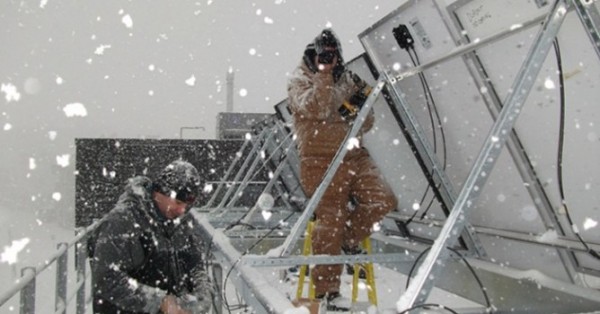Professor Joshua Pearce has been spending his days in Canada’s knee-deep powder, bouncing tennis balls off snow-covered solar panels in an attempt to solve a pressing problem for renewable energy – how do you harvest the sun’s power in the world’s snowy places?
The “tennis ball method” has proved effective at removing snow from small solar arrays because the ball’s impact exposes a small area of the panel, which is warmed by the sun and sheds the remaining snow. But Pearce, an engineering professor at Queens University in Kingston, Ontario, has a bigger goal in mind than removing snow one panel at a time. He and researchers from the Sustainable Energy Applied Research Center at nearby Saint Lawrence College’s are studying how solar panels perform in snowy climates. Earlier studies cited by the researchers have shown that snow cover can rob panels of up to 10 percent of their yearly performance.

The data on panels’ performance in the snow are important to the future of solar because almost three-quarters of all solar panels installed in 2009 are in countries that get at least some snow, according to Pearce and the market research firm Solarbuzz. The researchers are examining amorphous silicon and the more common crystalline silicon panels from about a dozen manufacturers and have sponsorships from DuPont Canada and National Resources Canada. They have learned, for example, that light reflecting off the snow can increase the irradiation of panels but, paradoxically, that means the panels sometime receive too much power.
Then there is the snow-removal issue. No idea to deal with snow is off the table, though the most common solution the researchers hear from their friends – windshield wipers for panels – probably wouldn’t be worth the added cost to install them, student researcher Rob Andrews said. The most promising solution for large solar installations is to coat the panels with a transparent, snow-shedding material.
Eventually, Andrews hopes to create a model that will allow anyone in the world to plug in weather conditions and find out what a solar farm will lose or gain in efficiency as a result of snow. It will help operators decide, for example, if it’s worth it to hire people to clear snow or whether panels should be heated to melt it.
Pearce said the data gathering could influence how companies design panels. “Today, solar cells are sold as commodities,” Pearce wrote in an email. “In the future there will be a big difference between an Ontario solar cell and one made for Arizona.”
![]() Editor’s Note: Like our new content partnership with Tecca we unveiled yesterday, today we begin one with Txchnologist. This site, edited and mostly written by Matthew Van Dusen, is “presented by GE” but claims editorial independence from it. We find the content interesting and will repost some of its material but, to keep things editorially separate, will not publish any stories from them specifically referencing GE products or services.
Editor’s Note: Like our new content partnership with Tecca we unveiled yesterday, today we begin one with Txchnologist. This site, edited and mostly written by Matthew Van Dusen, is “presented by GE” but claims editorial independence from it. We find the content interesting and will repost some of its material but, to keep things editorially separate, will not publish any stories from them specifically referencing GE products or services.